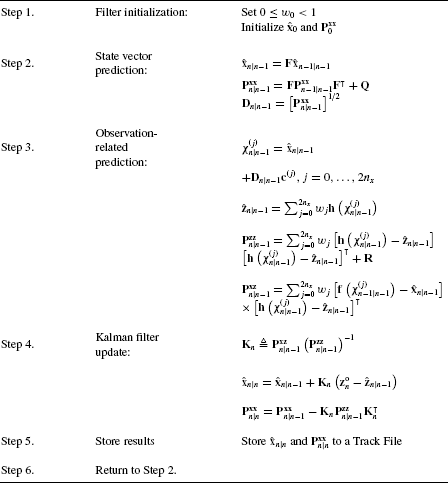9.3 Application of the UKF to the DIFAR Ship Tracking Case Study
Since the dynamic equation is linear for the DIFAR tracking problem, the UKF process used for this problem is shown in Table 9.2. Note that this process is generic for all sigma point Kalman filters, which will differ only in the values assigned to ![]() For the DIFAR case, in Table 9.2 we take
For the DIFAR case, in Table 9.2 we take ![]() for nx = 4. Thus, there are nine sigma points for this UKF since we included the sigma point at the origin. For the sigma points, the values used for
for nx = 4. Thus, there are nine sigma points for this UKF since we included the sigma point at the origin. For the sigma points, the values used for ![]() are given in (9.22) and (9.23), where we let
are given in (9.22) and (9.23), where we let ![]() . This UKF filter used the same initialization and dynamic noise q values used for the EKF, given in Sections 7.4.3 and 7.4.4, respectively.
. This UKF filter used the same initialization and dynamic noise q values used for the EKF, given in Sections 7.4.3 and 7.4.4, respectively.
Table 9.2 Multidimensional Sigma Point Kalman Filter Process Applied to DIFAR Tracking.

A comparison of 100 Monte Carlo output tracks for each of six different signal SNRs from a UKF tracker for the DIFAR case study with the plot for the EKF shown in Figure 7.3 reveals that the outputs at all signal dB levels ...
Get Bayesian Estimation and Tracking: A Practical Guide now with the O’Reilly learning platform.
O’Reilly members experience books, live events, courses curated by job role, and more from O’Reilly and nearly 200 top publishers.

